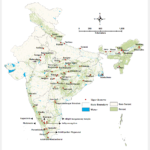What are Intellectual Property Rights

Trade-Related Aspects of Intellectual Property Rights (TRIPS)
BACKGROUND
Ideas and knowledge are an increasingly important part of trade. Most of the value of new medicines and other high-technology products lies in the amount of invention, innovation, research, design, and testing involved. Films, music recordings, books, computer software, and on-line services are bought and sold because of the information and creativity they contain, not usually because of the plastic, metal, or paper used to make them. Many products that used to be traded as low-technology goods or commodities now contain a higher proportion of invention and design in their value — for example, brand named clothing or new varieties of plants.
Creators can be given the right to prevent others from using their inventions, designs, or other creations — and to use that right to negotiate payment in return for others using them. “Intellectual property rights” given to persons over the creations of their minds. They usually give the creator an exclusive right over the use of his/her creation for a certain period of time.
Books, paintings, and films are examples of copyrighted works; you can patent inventions and register brand names and product logos as trademarks.
The extent of protection and enforcement of these rights varied widely around the world; and as intellectual property became more important in trade, these differences became a source of tension in international economic relations. Policymakers saw new internationally agreed trade rules for intellectual property rights as a way to introduce more order and predictability and settle disputes more systematically.
The TRIPS Agreement which came into effect on 1 January 1995, is to date the most comprehensive multilateral agreement on intellectual property.
The areas of intellectual property that it covers are copyright and related rights (i.e. the rights of performers, producers of sound recordings, and broadcasting organizations); trademarks; geographical indications; industrial designs; patents, including the protection of new varieties of plants; and undisclosed information including trade secrets.
It establishes minimum levels of protection that each government has to give to the intellectual property of fellow WTO members. In doing so, it strikes a balance between the long-term benefits and possible short-term costs to society.
The Doha Declaration, of WTO, responds to the concerns of developing countries about the obstacles they faced when seeking to implement measures to promote access to affordable medicines in the interest of public health in general, without limitation to certain diseases under the TRIPS agreement. It affirms that “the TRIPS Agreement does not and should not prevent Members from taking measures to protect public health”-affirmation of the right of WTO Members to make full use of the safeguard provisions of the TRIPS Agreement in order to protect public health and enhance access to medicines for poor countries.
India passed the Patents Amendment Act, 2005 which came into force on 1st January, 2005. Earlier India had allowed for the manufacture of generic versions of many drugs. Through this amendment, it has now implemented a product patent regime and product patents in the pharmaceutical sector. This amendment obliged India to grant product patents to drugs medicines and food and chemical products. This final amendment brought India into full compliance with its TRIPS obligations.
A sign or tag can designate agricultural, natural, or manufactured goods as a Geographical Indication. Products that have a specific geographical origin and possess qualities or a reputation or other characteristics that are due to that origin. A GI registration gives the registered proprietor and authorized users the legal right to the exclusive use of the GI, and no unauthorized person can use the tag. Community/association of producers enjoy community rights. Under WTO– Trade related Intellectual property rights (TRIPS), the Member nations have to respect geographical indications.
A GI is different from Trade Mark. A Trademark generally refers to a “brand” or “logo obtained for a business name, distinctive catchphrases, taglines or captions. Product comes from a particular enterprise/company, Right enjoyed by only one person/company; individual right. Can be goods (mobile, PC etc) or services (e.g.music, spa etc.). A trademark can last forever, so long as the owner continues to use the mark in commerce to indicate the source of goods and services; and identifies and distinguishes the source of the goods of one party from those of others.
A patent is a limited-duration property right or instrument of monopoly relating to an invention, in exchange for public disclosure of the invention. Patentable materials include machines, manufactured articles, industrial processes, and chemical compositions. A patent gives rights to exclude others from practicing one’s Invention; it does not give the right to use someone’s Invention.
A copyright protects songs, books, movies, and works of art that authors have tangibly expressed in a physical form.






0 Comments